
Article by Gilad Bloom
Many of the students I teach ask me how many hours a week they should train in order to reach the college level. The answer is … not that many. It’s the quality and the effort that counts. Anywhere between three to six times a week is a good start, no more than two hours per day, either in a group or private lesson. If you practice about 10-12 hours per week in total, that would still leave you ample time to work on academics and have a normal childhood.
I’m not a big believer in sending a child from their home environment to an “academy,” playing tennis all day and living in a dorm away from their parents. I believe that collegiate level tennis can be achieved while staying home and attending a regular school.
Having said that, I would also like to add that if you are looking to reach the professional level, I would strongly suggest home schooling as an option and to take a much heavier load of sessions. But to reach the collegiate level, even Division 1, a few things need to happen …
1. Great practice habits
This could be the most important aspect of a tennis player and something that every college coach appreciates. With good practice habits, you don’t have to train that long, and as long as the intensity is there, two hours of practice per day is plenty. Just make sure that you don’t take too many breaks (and if you do, make them short). Also, run down every ball without exception. I learned that from the top players in the world from my era. They were all animals on the practice court. In my opinion, when you spend five to six hours a day on the court, the level of concentration and quality declines, especially the intensity. It’s better to go all out for two hours and go home.
2. An extensive fitness program
This program should include one to two hours per week with a trainer, and another two or three times when you exercise on your own. Physical fitness was always an important aspect of the game, but in the past, you could get away with not being fit. Today, everyone is in shape … it’s a must. Proper stretching is essential as are regular visits to the trainer for physical sessions in order to stay injury-free.
3. Play another sport (preferably a team sport)
This current generation is not at all a “Ball Handling Generation,” unless it’s a video game. Tennis is a one-sided, asymmetrical sport that can cause an imbalance in the body (especially the back). Playing other sports will help balance the body, prevent injuries and improve coordination. Playing a team sport is a nice relief for a tennis player who is used to being on their own all the time. Sure, we all love the individuality of the sport of tennis, but it’s nice to be with the boys/girls out there on the field and develop the ability to win and lose as a team.
4. Find an outside hobby
A musical instrument as an outside interest off the court is highly recommended. We all know how hard and stressful the game of tennis can be at the competitive level. A player needs something to fall back on when things are hard—a release, an escape, something that relaxes them. A musical instrument can be carried around to tournaments, but so can books, chess, movies, art or anything. The point is, there are things out there other than tennis. This can be very useful at a time when injuries are a part of the game.
5. Play tournaments regularly on weekends
After the age of 12, I’d recommend at least two tournaments per month. Weekend tournaments are essential to the development of the junior player, there is no substitute to a real USTA match. Competition is the breeding ground for improvement and staying sharp for matches throughout your junior years will bring you to college with ample experience in tight matches.
6. Step it up during the summer and when on vacations
When off from school, kids should take advantage and double their sessions to twice a day. This is the time to push it a bit. Without the burden of school and with a good night’s sleep, most kids are more coachable and are easier to push to the limit. Just make sure they play, mostly on clay, five to six hours each day.
7. Take breaks
Make sure that kids take two or three breaks per year, at least one week at a time. It is very important to get away from the game from time to time, in order to recharge and plan the next step or to just forget about it all and disconnect. Breaks are also vital in the sense they can also prevent future burnout.
8. Combine private lessons with group sessions
Having one-on-one lessons is irreplaceable. Some parents sign their kids up only for group lessons and that is a mistake. Specific corrections can only be given effectively in private lessons. The instructions in a group setting are a follow up to what happens in a private lesson. A combination is ideal as group lessons are usually more fun and allow kids to interact and compete. Keep the lessons fun and enjoy the journey, even if it’s filled with hard work.

Gilad Bloom
Former Israeli Davis Cup player and two-time Olympian
Follow Chris at these websites and social media links:
Website: www.chrislewit.com
Blog: www.ProdigyMaker.com
Facebook: www.facebook.com/ChrisLewitTennisAcademy
Twitter: www.twitter.com/chrislewit
LinkedIn: www.linkedin.com/company/chris-lewit-tennis-academy
Instagram: www.instagram.com/chrislewittennis/
YouTube: www.youtube.com/ChrisLewit
iTunes: https://podcasts.apple.com/us/podcast/the-prodigy-maker-tennis-show/






